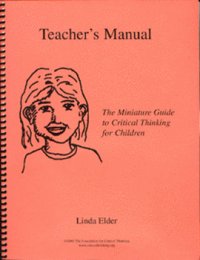Teacher’s Manual for the Miniature Guide to Critical Thinking for Children
Gain digital access to this and many other resources at the Center for Critical Thinking Community Online!
(Physical copies not available at this time.)
Author: Dr. Linda Elder
Publisher: Foundation for Critical Thinking
Pages: 61
Dimensions: 8 1/2" x 11"
One of our most popular publications, this Teacher’s manual provides teachers with instructional strategies for using The Miniature Guide to Critical Thinking for Children. It includes the following:
- The Miniature Guide to Critical Thinking Concepts and Tools, a resource that briefly introduces teachers to the critical thinking concepts and theory they need to effectively teach children to improve their thinking and learning.
- One copy of The Miniature Guide to Critical Thinking for Children.
- Suggestions for using The Miniature Guide to Critical Thinking for Children and teaching basic critical thinking concepts.
- “Think for Yourself” (TFY) activities for children which help them internalize critical thinking concepts. If your children are at the k–2 level or have reading difficulties, you can use the exercises as idea generators for verbally teaching the concepts.
$0.00
Additional Information About:
Teacher’s Manual for the Miniature Guide to Critical Thinking for Children
All of the ideas in this manual have been used with elementary students. Ideally children will have their own copy of The Miniature Guide to Critical Thinking for Children. As you use this mini-guide on a daily basis in your classes, children will begin to internalize critical thinking concepts and develop their reasoning abilities. Included in the Teacher’s Manual are strategies for using the masks of Fairminded Fran, Naïve Nancy, and Selfish Sam. These characters can be used in helping children distinguish between skilled and unskilled thinking, as well as fair and unfair thinking.
Contents:
Thirty-Five Dimensions of Critical Thought
Part One: Fictional Characters That Help Children Understand Critical Thinking
Introduction: Meet Naïve Nancy, Selfish Sam, and Fairminded Fran
A Critical Reading Format Role Playing Naïve Nancy, Selfish Sam, Fairminded Fran
Think For Yourself Activities For Children:
TFY #1: Describe Naïve Nancy, Selfish Sam and Fairminded Fran
TFY #2: Who are You Most Like? Nancy, Sam or Fran
Part Two: Fair and Unfair Thinking
Introducing Fair/Unfair Thinking
Using Journal Entries
Think For Yourself Activities For Children:
TFY #3: When Are You Fair? When Are You Unfair?
TFY #4: Thinking About When I Am Fair and Unfair - Journal Entry Format
Part Three: The Intellectual Standards
Introduction: Helping Children Evaluate Thinking
Clarity, Accuracy, Relevance, Logic, Fairness
Part Four: The Parts of Thinking
Introduction: Helping Children Analyze Thinking
Focusing on the Parts of Thinking as a Whole
Questions We Can Ask When We Understand the Parts of Thinking
Think For Yourself Activities For Children:
TFY #5: Analyze the Parts of Your Thinking When You Are Solving a Problem
TFY #6: Analyze the Parts of Thinking Of a Character in a Story
TFY #7: Working With Inferences
TFY #8: Understanding the Difference Between Inferences and Assumptions
TFY #9: Correcting for Faulty Inferences
TFY #10: Understanding Inferences
TFY #11: Faulty Assumptions People Sometimes Make Which Lead to Prejudices
Helping Children Think Critically About Ideas and Concepts
Leading a Socratic Question Dialog Focusing on Key Concepts
Think For Yourself Activities For Children:
TFY#12: Understanding the Concept of Greed
TFY#13: Understanding the Concept of Prejudice
TFY#14: Understanding the Concept of Cooperation
Part Five: The Intellectual Virtues
Introduction: Helping Children Develop Character and Internal Motivation
Think For Yourself Activities For Children:
TFY #15: Understanding Intellectual Perseverance
TFY #16: Understanding Intellectual Independence
